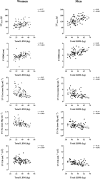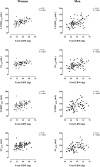Lean body mass and the cardiorespiratory phenotype: An ethnic-specific relationship in Hans Chinese women and men
- PMID: 38632694
- PMCID: PMC11154775
- DOI: 10.1002/jcsm.13464
Lean body mass and the cardiorespiratory phenotype: An ethnic-specific relationship in Hans Chinese women and men
Abstract
Background: Lean body mass (LBM) and the functional capacity of cardiovascular (CV) and respiratory systems constitute a female-specific relationship in European-American individuals. Whether this recent finding be extrapolated to the world's largest ethnic group, that is, Hans Chinese (HC, a population characterized by low LBM), is unknown.
Methods: Healthy HC adults (n = 144, 50% ♀) closely matched by sex, age and physical activity were included. Total and regional (leg, arm and trunk) LBM and body composition were measured via dual-energy X-ray absorptiometry. Cardiac structure, stiffness, central/peripheral haemodynamics and peak O2 consumption (VO2peak) were assessed via transthoracic echocardiography and pulmonary gas analyses at rest and during exercise up to peak effort. Regression analyses determined the sex-specific relationship of LBM with cardiac and aerobic phenotypes.
Results: Total and regional LBM were lower and body fat percentage higher in women compared with men (P < 0.001). In both sexes, total LBM positively associated with left ventricular (LV) mass and peak volumes (r ≥ 0.33, P ≤ 0.005) and negatively with LV end-systolic and central arterial stiffness (r ≥ -0.34, P ≤ 0.004). Total LBM strongly associated with VO2peak (r ≥ 0.60, P < 0.001) and peak cardiac output (r ≥ 0.40, P < 0.001) in women and men. Among regional LBM, leg LBM prominently associated with the arterio-venous O2 difference at peak exercise in both sexes (r ≥ 0.43, P < 0.001). Adjustment by adiposity or CV risk factors did not modify the results.
Conclusions: LBM independently determines internal cardiac dimensions, ventricular mass, distensibility and the capacity to deliver and consume O2 in HC adults irrespective of sex.
Keywords: Aerobic capacity; Body composition; Cardiovascular structure/function; Hans Chinese; Lean body mass; O2 extraction.
© 2024 The Authors. Journal of Cachexia, Sarcopenia and Muscle published by Wiley Periodicals LLC.
Conflict of interest statement
The authors declare that they have no competing interests.
Figures





Similar articles
-
Lean body mass and the cardiovascular system constitute a female-specific relationship.Sci Transl Med. 2022 Oct 19;14(667):eabo2641. doi: 10.1126/scitranslmed.abo2641. Epub 2022 Oct 19. Sci Transl Med. 2022. PMID: 36260693
-
The Chinese cardiorespiratory and circulatory system at work in women and men: a case-control study.Lancet Reg Health West Pac. 2023 Nov 18;43:100975. doi: 10.1016/j.lanwpc.2023.100975. eCollection 2024 Feb. Lancet Reg Health West Pac. 2023. PMID: 38058739 Free PMC article.
-
Sex dimorphism in cardiac and aerobic capacities: The influence of body composition.Obesity (Silver Spring). 2021 Nov;29(11):1749-1759. doi: 10.1002/oby.23280. Obesity (Silver Spring). 2021. PMID: 34734496
-
Relationship of Cardiac Structure and Function to Cardiorespiratory Fitness and Lean Body Mass in Adolescents and Young Adults with Type 2 Diabetes.J Pediatr. 2016 Oct;177:159-166.e1. doi: 10.1016/j.jpeds.2016.06.048. Epub 2016 Aug 4. J Pediatr. 2016. PMID: 27499218 Free PMC article.
-
Vitamin D status, body composition and hypertensive target organ damage in primary hypertension.J Steroid Biochem Mol Biol. 2014 Oct;144 Pt A:180-4. doi: 10.1016/j.jsbmb.2013.10.026. Epub 2013 Nov 1. J Steroid Biochem Mol Biol. 2014. PMID: 24189544 Review.
Cited by
-
Ultrasound cut-off values for muscle thickness, cross-sectional area, and echo intensity in Caucasian adults: a narrative review.Quant Imaging Med Surg. 2025 Apr 1;15(4):3665-3686. doi: 10.21037/qims-24-2122. Epub 2025 Mar 28. Quant Imaging Med Surg. 2025. PMID: 40235819 Free PMC article. Review.
References
-
- Von Dobeln W. Human standard and maximal metabolic rate in relation to fat‐free body mass. Acta Physiol Scand Suppl 1956;37:1–79. - PubMed
-
- Diaz‐Canestro C, Pentz B, Sehgal A, Montero D. Sex dimorphism in cardiac and aerobic capacities: the influence of body composition. Obesity (Silver Spring) 2021;29:1749–1759. - PubMed
-
- Diaz‐Canestro C, Pentz B, Sehgal A, Yang R, Xu A, Montero D. Lean body mass and the cardiovascular system constitute a female‐specific relationship. Sci Transl Med 2022;14:eabo2641. - PubMed
-
- Metra M, Faggiano P, D'Aloia A, Nodari S, Gualeni A, Raccagni D, et al. Use of cardiopulmonary exercise testing with hemodynamic monitoring in the prognostic assessment of ambulatory patients with chronic heart failure. J Am Coll Cardiol 1999;33:943–950. - PubMed
MeSH terms
Grants and funding
LinkOut - more resources
Full Text Sources

